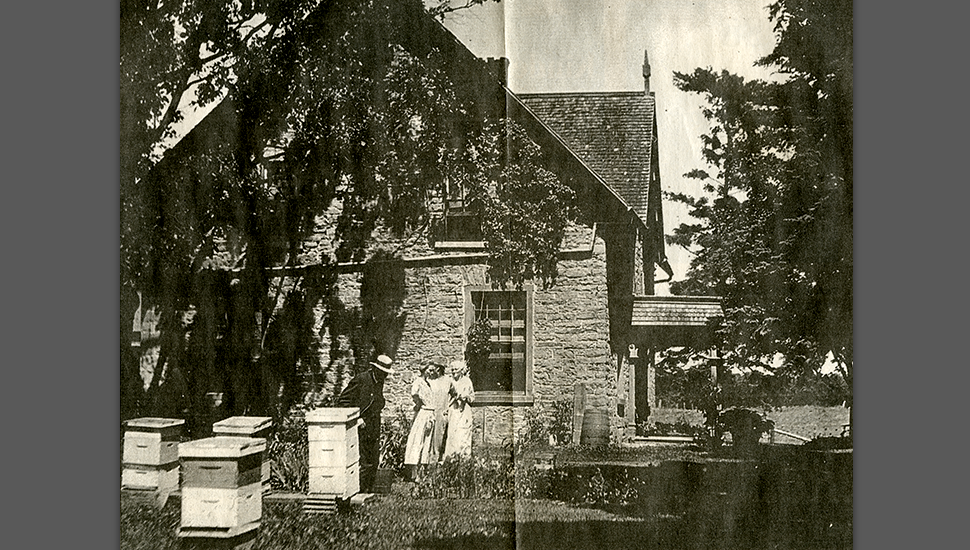47. Stephen Collins House
Construction: circa 1830
Architect: Unknown
Location: 3436 Prince of Wales Drive, Ottawa
This historic stone cottage was built circa 1830 by Thomas Moodie, a stonemason working on the construction of the Rideau Canal. It served as the Paymasters’ house before United Empire Loyalist Captain Stephen Collins, who served in the Grenville Militia in the War of 1812, took possession of it. Collins became a prominent figure in local government in the 1830s and 1840s.
As built, the house was a 1 ½-storey stone structure facing the Rideau River. It had a low-pitched roof and large 12-over-12 multi-paned sash windows. The masonry is composed of rubble stone walls and dressed cornerstones. The Stephen Collins House is an important component of the unique cultural landscape adjacent to a Canadian Heritage River that has long been recognized as an integral part of the heritage character of the Rideau Corridor.
The Collins family resided in the house until 1884 when it was sold to James Mansfield of Perth. Renovations undertaken at the time included altering the pitch of the roof, adding front and back gables with “gingerbread” trim and a 2-storey verandah.
The Mansfield’s occupied the house until 1958, when it was sold to the Shenkman Corporation. It was rented out to various tenants for the next 40 years.
The Stephen Collins House and approximately 1.5 acres of land were designated under Part IV of the Ontario Heritage Act by the former City of Nepean in 1988.
In 2000, structural restoration consultant Craig Sims was hired to inspect the house. His report of October 23 concluded that it was sound and contained many rare architectural features of the period of its construction and from the Victorian era when it underwent renovations.
The threat to the Stephen Collins House arose in 2000 when it was deemed an impediment to a proposed new subdivision called Chapman Mills, planned by the South Nepean Development Corporation (SNDC), a partnership of Minto Developments Ltd. and the Shenkman Corporation.
SNDC’s discussions on the property with the former City of Nepean were based on the retention of the historic home and its integration into the newly planned community as a separate block.
The August 3, 2000 application to demolish the building by SNDC was therefore unexpected and according to Planning Department documents was “a new and unforeseen development in the planning for the Chapman Mill community.”
Heritage Ottawa only became aware of the site being threatened with demolition in January 2001, after the region’s 11 municipalities amalgamated into one city.
On January 22, 2001, then president Carolyn Quinn wrote to the president of Minto Developments Inc., Roger Greenberg, reminding him of SNDC’s important stewardship role. “Give the Chapman Mills’ slogan ‘building a community of the future with roots in the past’ real significance by pursuing all available means for the preservation of this rare historic house that contributes so much to the cultural heritage of our new city,” wrote Quinn.
Heritage Ottawa’s offer to help find a solution that would see the house conserved on site was taken seriously by SNDC. Mr. Greenberg indicated that Minto was open to a creative solution and he authorized Heritage Ottawa’s access to the property in February, 2001.
On March 22, 2001, Carolyn Quinn, Sandy Smallwood of Andrex Holdings, and conservation architect Julian Smith met with Minto vice-president Regis Trudel to discuss possible options for saving the house on site included a land exchange agreement, which the City was open to discussing.
To raise public awareness about the issue, Quinn alerted print, radio and television media about the pending demolition and kept them apprised of developments. It generated ongoing coverage, resulting in considerable public protest.
In March 2001, SNDC agreed to defer the application to demolish to allow more time for a negotiated solution.
By the end of the year, the SNDC announced that Ottawa Valley Autistic Homes (OVAH) would be the recipient of a long-term lease, at no cost, for the Stephen Collins House that included connections for water, sanitary and storm water services also at no cost. The City agreed to waive all applicable development charges and fees.
The OVAH, however, was unable to raise the funds needed to adapt the house for use as a group home.
In 2005, the property sold to developer Ted Phillips of Taggart Group, who rehabilitated it as his private residence.
The Stephen Collins House remains a private residence today. Extensive tree planting has hidden the house from public view.





